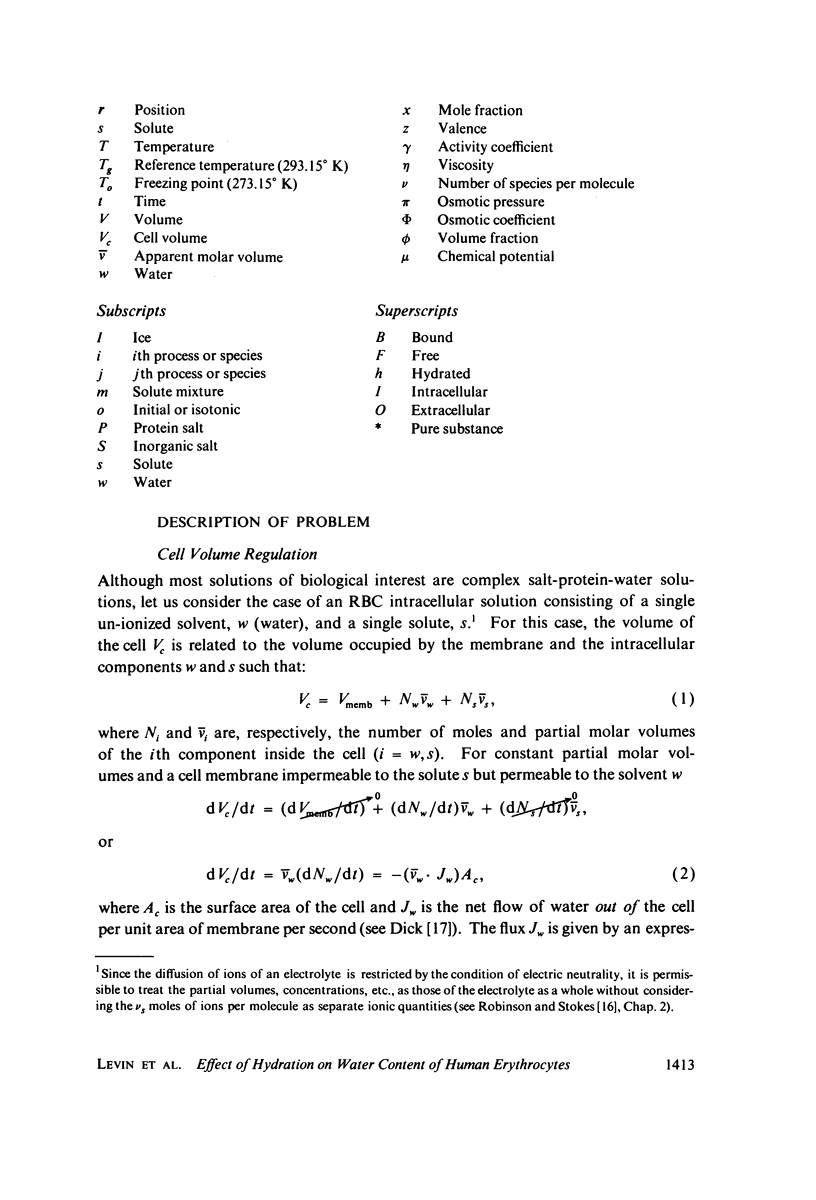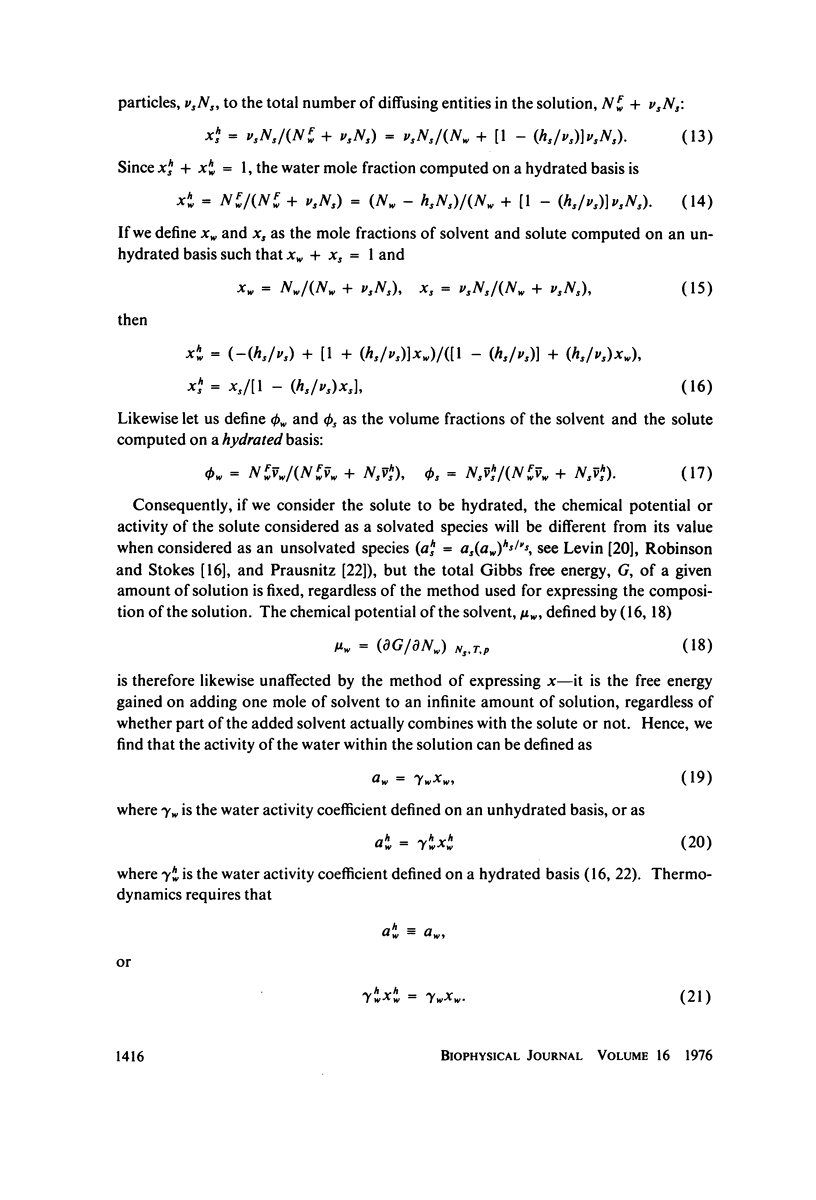Abstract
An ideal, hydrated, nondilute pseudobinary salt-protein-water solution model of the RBC intracellular solution has been developed to describe the osmotic behavior of human erythrocytes during freezing and thawing. Because of the hydration of intracellular solutes (mostly cell proteins), our analytical results predict that at least 16.65% of the isotonic cell water content will be retained within RBCs placed in hypertonic solutions. These findings are consistent not only with the experimental measurements of the amount of isotonic cell water retained within RBCs subjected to nonisotonic extracellular solutions (20-32%) but also with the experimental evidence that all of the water within RBCs is solvent water. By modeling the RBC intracellular solution as a hydrated salt-protein-water solution, no anomalous osmotic behavior is apparent.
Full text
PDF















Selected References
These references are in PubMed. This may not be the complete list of references from this article.
- CARR C. W. Studies on the binding of small ions in protein solutions with the use of membrane electrodes. VI. The binding of sodium and potassium ions in solutions of various proteins. Arch Biochem Biophys. 1956 Jun;62(2):476–484. doi: 10.1016/0003-9861(56)90146-1. [DOI] [PubMed] [Google Scholar]
- Canham P. B., Burton A. C. Distribution of size and shape in populations of normal human red cells. Circ Res. 1968 Mar;22(3):405–422. doi: 10.1161/01.res.22.3.405. [DOI] [PubMed] [Google Scholar]
- Colombe B. W., Macey R. I. Effects of calcium on potassium and water transport in human erythrocyte ghosts. Biochim Biophys Acta. 1974 Sep 6;363(2):226–239. doi: 10.1016/0005-2736(74)90062-5. [DOI] [PubMed] [Google Scholar]
- Cook J. S. Nonsolvent water in human erythrocytes. J Gen Physiol. 1967 May;50(5):1311–1325. doi: 10.1085/jgp.50.5.1311. [DOI] [PMC free article] [PubMed] [Google Scholar]
- DRABKIN D. L. Spectrophotometric studies. XV. Hydration of macro sized crystals of human hemoglobin, and osmotic concentrations in red cells. J Biol Chem. 1950 Jul;185(1):231–245. [PubMed] [Google Scholar]
- Diller K. R., Cravalho E. G., Huggins C. E. An experimental study of freezing in erythrocytes. Med Biol Eng. 1976 May;14(3):321–326. doi: 10.1007/BF02478129. [DOI] [PubMed] [Google Scholar]
- Evans E., Fung Y. C. Improved measurements of the erythrocyte geometry. Microvasc Res. 1972 Oct;4(4):335–347. doi: 10.1016/0026-2862(72)90069-6. [DOI] [PubMed] [Google Scholar]
- Farrant J. Human red cells under hypertonic conditions; a model system for investigating freezing damage. 3. Dimethylsulfoxide. Cryobiology. 1972 Apr;9(2):131–136. doi: 10.1016/0011-2240(72)90020-x. [DOI] [PubMed] [Google Scholar]
- Gary-Bobo C. M., Solomon A. K. Properties of hemoglobin solutions in red cells. J Gen Physiol. 1968 Nov;52(5):825–853. doi: 10.1085/jgp.52.5.825. [DOI] [PMC free article] [PubMed] [Google Scholar]
- Kwant W. O., Seeman P. The erythrocyte ghost is a perfect osmometer. J Gen Physiol. 1970 Feb;55(2):208–219. doi: 10.1085/jgp.55.2.208. [DOI] [PMC free article] [PubMed] [Google Scholar]
- LOVELOCK J. E. The haemolysis of human red blood-cells by freezing and thawing. Biochim Biophys Acta. 1953 Mar;10(3):414–426. doi: 10.1016/0006-3002(53)90273-x. [DOI] [PubMed] [Google Scholar]
- LOVELOCK J. E. The mechanism of the protective action of glycerol against haemolysis by freezing and thawing. Biochim Biophys Acta. 1953 May;11(1):28–36. doi: 10.1016/0006-3002(53)90005-5. [DOI] [PubMed] [Google Scholar]
- Levin R. L., Cravalho E. G., Huggins C. E. A membrane model describing the effect of temperature on the water conductivity of erythrocyte membranes at subzero temperatures. Cryobiology. 1976 Aug;13(4):415–429. doi: 10.1016/0011-2240(76)90097-3. [DOI] [PubMed] [Google Scholar]
- MAZUR P. KINETICS OF WATER LOSS FROM CELLS AT SUBZERO TEMPERATURES AND THE LIKELIHOOD OF INTRACELLULAR FREEZING. J Gen Physiol. 1963 Nov;47:347–369. doi: 10.1085/jgp.47.2.347. [DOI] [PMC free article] [PubMed] [Google Scholar]
- MILLER D. M. SUGAR UPTAKE AS A FUNCTION OF CELL VOLUME IN HUMAN ERYTHROCYTES. J Physiol. 1964 Jan;170:219–225. doi: 10.1113/jphysiol.1964.sp007325. [DOI] [PMC free article] [PubMed] [Google Scholar]
- MORRIS R., WRIGHT R. D. On the interaction of haemoglobin with sodium and potassium. Aust J Exp Biol Med Sci. 1954 Oct;32(5):669–676. doi: 10.1038/icb.1954.69. [DOI] [PubMed] [Google Scholar]
- Mansoori G. A. Kinetics of water loss from cells at subzero centigrade temperatures. Cryobiology. 1975 Feb;12(1):34–45. doi: 10.1016/0011-2240(75)90039-5. [DOI] [PubMed] [Google Scholar]
- Mazur P., Leibo S. P., Chu E. H. A two-factor hypothesis of freezing injury. Evidence from Chinese hamster tissue-culture cells. Exp Cell Res. 1972;71(2):345–355. doi: 10.1016/0014-4827(72)90303-5. [DOI] [PubMed] [Google Scholar]
- Mazur P. The role of cell membranes in the freezing of yeast and other single cells. Ann N Y Acad Sci. 1965 Oct 13;125(2):658–676. doi: 10.1111/j.1749-6632.1965.tb45420.x. [DOI] [PubMed] [Google Scholar]
- Meryman H. T. Modified model for the mechanism of freezing injury in erythrocytes. Nature. 1968 Apr 27;218(5139):333–336. doi: 10.1038/218333a0. [DOI] [PubMed] [Google Scholar]
- RAND R. P., BURTON A. C. Area and volume changes in hemolysis of single erythrocytes. J Cell Comp Physiol. 1963 Jun;61:245–253. doi: 10.1002/jcp.1030610306. [DOI] [PubMed] [Google Scholar]
- SAVITZ D., SIDEL V. W., SOLOMON A. K. OSMOTIC PROPERTIES OF HUMAN RED CELLS. J Gen Physiol. 1964 Sep;48:79–94. doi: 10.1085/jgp.48.1.79. [DOI] [PMC free article] [PubMed] [Google Scholar]
- Tanford C., Nozaki Y. Titration of the histidyl and alpha-amino groups of hemoglobin. J Biol Chem. 1966 Jun 25;241(12):2832–2839. [PubMed] [Google Scholar]


